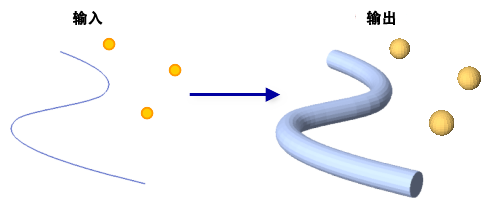摘要
围绕点或线创建三维缓冲区以生成球形或圆柱形的多面体要素。
插图

用法
此工具的输出是闭合多面体要素,可用于体积计算和其他 3D 集合运算符工具。
考虑指定一个简化值以提高复杂线要素(例如带有大量折点的曲线)的性能。
如果线几何和缓冲距离生成折点密集的重叠区域,则此工具可能无法生成某些线要素的闭合多面体。一般来说,最好避开可能会导致在同一要素内创建重叠区域的缓冲距离。
语法
Buffer3D_3d (in_features, out_feature_class, buffer_distance_or_field, {buffer_joint_type}, {buffer_quality}, {simplification_tolerance})| 参数 | 说明 | 数据类型 |
in_features | 待缓冲的线或点要素。 | Feature Layer |
out_feature_class | 包含 3D 缓冲区的输出多面体。 | Feature Class |
buffer_distance_or_field | 输入要素缓冲区周围的距离,可作为线性距离提供或从输入要素属性表中的数值字段得出。如果已通过输入字段指定缓冲距离,则将通过要素空间参考获得其测量单位。如果已将线性距离指定为数值,则支持以下测量单位:
| Linear Unit; Field |
buffer_joint_type (可选) |
线段折点之间的缓冲区形状。此参数只对线输入要素有效。
| String |
buffer_quality (可选) | 用于表示生成的多面体要素的线段数。默认为 20,但可输入 6 到 60 范围内的任何数字。缓冲质量值越高,生成的 3D 要素越平滑,但同时也会增加处理时间。 | Long |
simplification_tolerance (可选) | 简化输入线,方法是以原始格式保持它们在指定偏移范围内的形状。如果未指定值,则不会进行简化。支持以下测量单位:
| Linear Unit |
代码实例
Buffer3D 示例 1(Python 窗口)
下面的示例演示了如何在 Python 窗口中使用此工具。
import arcpy
from arcpy import env
arcpy.CheckOutExtension('3D')
env.workspace = 'C:/data'
arcpy.Buffer3D_3d('lineFC.shp', 'buffer3d.shp', '15 Meters',
'Round', 30, '1 Meters')
Buffer3D 示例 2(独立脚本)
下面的示例演示了如何在独立 Python 脚本中使用此工具。
'''****************************************************************************
Name: Buffer 3D Example
Description: This script demonstrates an application of
the Buffer 3D and Inside 3D tools.
****************************************************************************'''
# Import system modules
import arcpy
from arcpy import env
import exceptions, sys, traceback
try:
# Obtain a license for the ArcGIS 3D Analyst extension
arcpy.CheckOutExtension('3D')
# Set environment settings
env.workspace = 'C:/data'
# Set Local Variables
inFC = 'lineFC.shp'
bufferOut = 'buffer3d.shp'
# Execute Buffer 3D
arcpy.Buffer3D_3d(inFC, bufferOut, '15 Meters', 'Round', '30', '1 Meters')
arcpy.Inside3D_3d(bufferOut, 'survey_pts.shp', 'inside_analysis.dbf')
except arcpy.ExecuteError:
print arcpy.GetMessages()
except:
# Get the traceback object
tb = sys.exc_info()[2]
tbinfo = traceback.format_tb(tb)[0]
# Concatenate error information into message string
pymsg = 'PYTHON ERRORS:\nTraceback info:\n{0}\nError Info:\n{1}'\
.format(tbinfo, str(sys.exc_info()[1]))
msgs = 'ArcPy ERRORS:\n {0}\n'.format(arcpy.GetMessages(2))
# Return python error messages for script tool or Python Window
arcpy.AddError(pymsg)
arcpy.AddError(msgs)